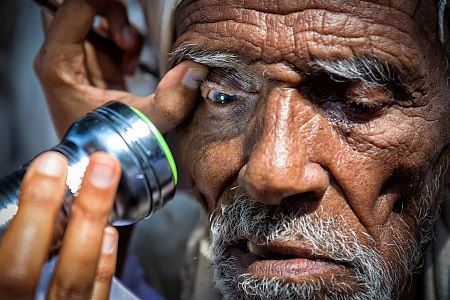Vision Aid Overseas’ success in southern Ethiopia
With a population of 94 million people scattered across remote and often hard to reach areas, Ethiopia is a rapidly developing country, and is emerging from some of the worst trappings of extreme poverty that existed a decade or so ago.
In 2013, the Department for International Development (DFID) awarded Vision Aid Overseas with a major grant to help improve the livelihoods of people living in five districts of southern Ethiopia by increasing access to primary eye care, glasses and treatment for eye diseases. The grant was co-funded by Essilor UK Ltd with cash, spectacles and lenses.
Working in partnership with Ethiopian NGO, Grarbet Tehadiso Mahber (GTM), Vision Aid Overseas has delivered eye care services directly to the door steps of remote and isolated communities where previously such services simply did not exist. After three successful years of working in partnership with DFID, Essilor UK Ltd and GTM, Vision Aid Overseas was able to:
- Screen 184,491 people for eye conditions, with 50 per cent of them being women and girls
- Provide life changing glasses to 14,909 patients
- Treat 5,150 patients for minor surgery to correct their vision
- Train 710 teachers to screen school children and identify common eye problems
By making eye care services accessible to remote and isolated communities, a final year survey showed that:
- Of the adults surveyed after receiving treatment in the form of minor surgery or the provision of glasses, 78 per cent reported an improvement in their quality of life and an increase in household income after the treatment
- Out of the 2,569 children treated under the project, 73 per cent showed improvements in their school performance since receiving treatment
Anne Buglass, director of programmes said: “Over £200 billion worth of productivity is lost every year simply because people do not have the glasses they need to see clearly. The outcome of the three-year programme showed that when eye care is made accessible, adults are more likely to increase their household income and children are more likely to reach their potential in school, achieve better education, and in the long term have greater economic prospects when they leave school. Ultimately we want to see fewer people living in poverty because of poor eye sight, and this project has shown that this is an attainable goal.”
The target number of people reached under this project far exceeded expectations, meaning messages about the importance of good eye health reached over twice as many people than first anticipated.
To find out more about how you can support the work of Vision Aid Overseas, visit: www.visionaidoverseas.org.
